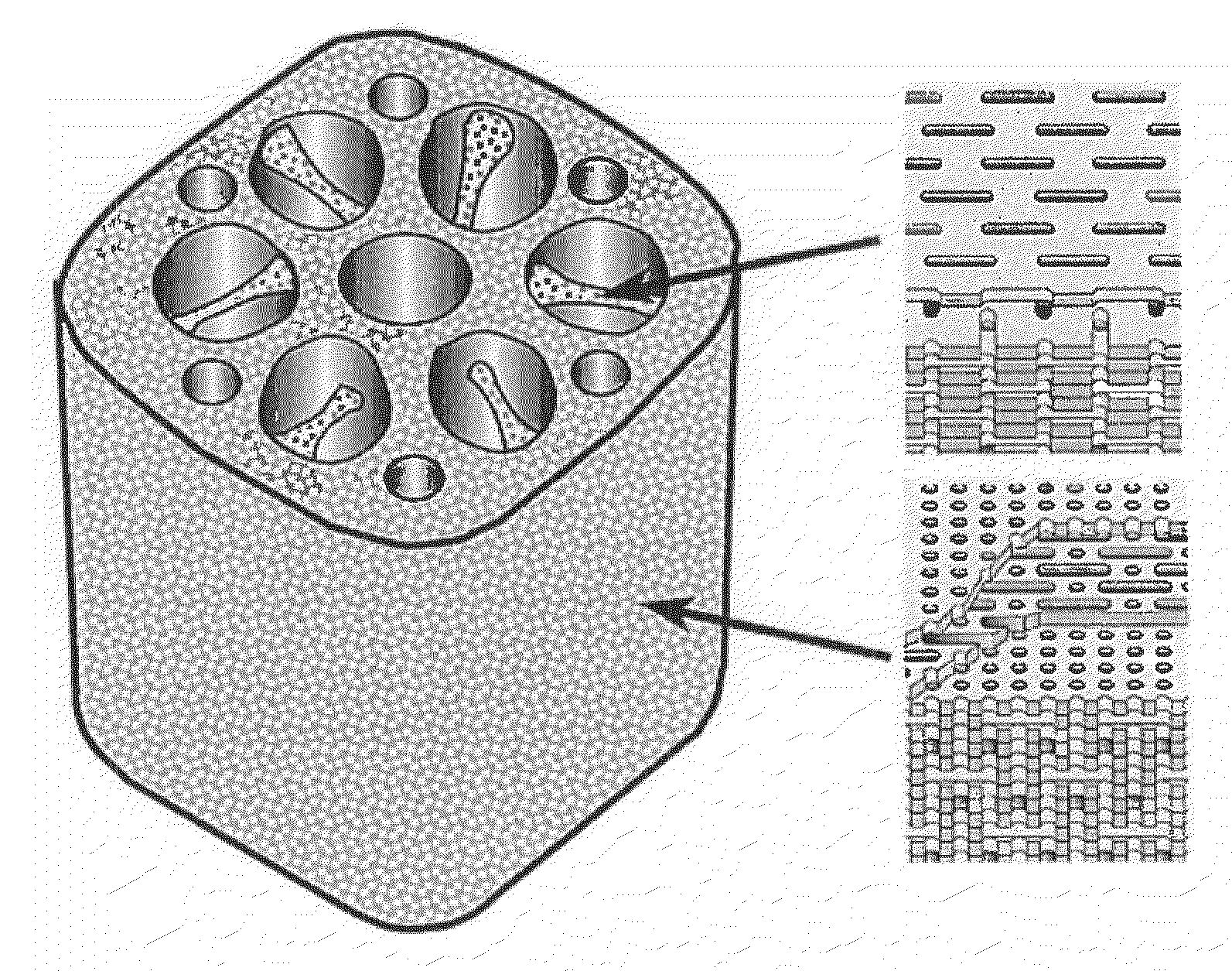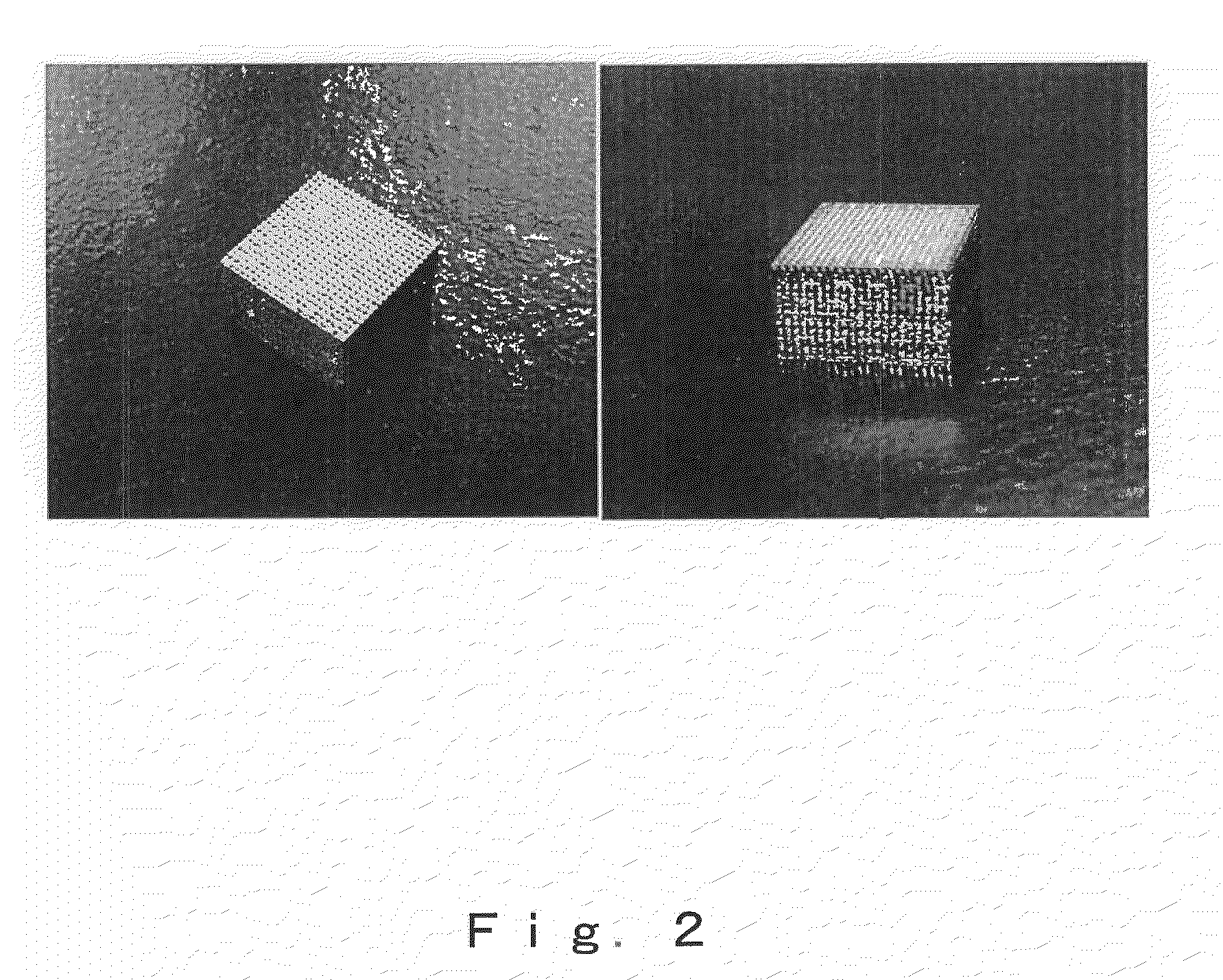Biomaterial, method of constructing the same and use thereof
a biomaterial and biomaterial technology, applied in the field of porous biomaterials, can solve the problems of poor mechanical match between bone at the site of implantation and surrounding bone as part of the skeleton, loss of bone mass in surrounding bones and joints, and destruction of cartilage, etc., and achieve the effect of reasonable cost and simplified orientation
- Summary
- Abstract
- Description
- Claims
- Application Information
AI Technical Summary
Benefits of technology
Problems solved by technology
Method used
Image
Examples
example 1
Stacking of Titanium Sheets
[0108]Three 100 μm thick titanium sheets having circular throughholes of 150 μm radius (shape: FIG. 1a) and three 100 μm thick titanium sheets having circular holes of 150 μm radius and throughholes of 300 μm width and 1,200 μm length (shape: FIG. 1b) were alternately stacked, and the titanium sheets were diffusion bonded to each other by heating in a vacuum at from 500 to 1,500° C. for a period of from 1 to 500 minutes while applying a pressure of from 10 to 500 kg / cm2.
[0109]This gave a bulk porous body made of titanium characterized by being a porous body having therein a group of oriented pores of individually controlled size, shape and direction and with an orientation in one direction and also having formed therein connecting pores that link together the oriented pores and enable the passage of bodily fluids and gas bubbles, and by being formed with a controlled spatial configuration of the oriented pores and connecting pores (FIGS. 2 and 3). It was p...
example 2
Stacking of Polylactic Acid Sheets
[0110]A 300 μm thick polylactic acid sheet having circular throughholes of 150 μm radius (shape: FIG. 1a) and a 300 μm thick polylactic acid sheet having circular holes of 150 μm radius and throughholes of 300 μm width and 1,200 μm length (shape: FIG. 1b) were stacked, and the polylactic acid sheets were fusion bonded to each other by heating in the open air at from 80 to 200° C. for a period of from 1 to 500 minutes while applying a pressure of from 0.1 to 10 kg / cm2.
[0111]This gave a bulk porous body made of polylactic acid characterized by being a porous body having therein a group of oriented pores of individually controlled size, shape and direction and with an orientation in one direction and also having formed therein connecting pores that link together the oriented pores and enable the passage of bodily fluids and gas bubbles, and by being formed with a controlled spatial configuration of the oriented pores and connecting pores. It was possib...
example 3
Stacking of Polylactic Acid Sheet and Titanium Sheet
[0112]A 100 μm thick titanium sheet having circular throughholes of 150 μm radius (shape: FIG. 1a) and a 300 μm thick polylactic acid sheet having circular holes of 150 μm radius and throughholes of 300 μm width and 1,200 μm length (shape: FIG. 1b) were stacked, and the sheets were fusion bonded by heating in the open air at from 80 to 200° C. for a period of from 1 to 500 minutes while applying a pressure of from 0.1 to 10 kg / cm2. This gave a bulk porous body made of polylactic acid and titanium that was characterized by being a porous body having therein a group of oriented pores of individually controlled size, shape and direction and with an orientation in one direction and also having formed therein connecting pores that link together the oriented pores and enable the passage of bodily fluids and gas bubbles, and by being formed with a controlled spatial configuration of the oriented pores and connecting pores.
PUM
| Property | Measurement | Unit |
|---|---|---|
| Length | aaaaa | aaaaa |
| Length | aaaaa | aaaaa |
| Thickness | aaaaa | aaaaa |
Abstract
Description
Claims
Application Information
 Login to View More
Login to View More - R&D
- Intellectual Property
- Life Sciences
- Materials
- Tech Scout
- Unparalleled Data Quality
- Higher Quality Content
- 60% Fewer Hallucinations
Browse by: Latest US Patents, China's latest patents, Technical Efficacy Thesaurus, Application Domain, Technology Topic, Popular Technical Reports.
© 2025 PatSnap. All rights reserved.Legal|Privacy policy|Modern Slavery Act Transparency Statement|Sitemap|About US| Contact US: help@patsnap.com



